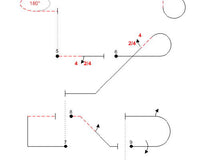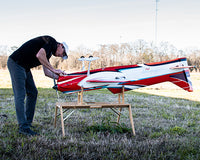This article is written by valued CK Aero contributor Earl Haury
Various opinions exist as to how subtrims affect servo travel, especially when used with dual servos on elevators. This discussion shows data that can help understand subtrims. While the measuring equipment was setup I made a few more measurement to satisfy my curiosity. A comparison of the performance of old with new servos, trim effect, and expo data are shown.
Correct geometry of linkages connecting the servo to the control surface is paramount. Subtrims should not be used to adjust surface neutrals at the expense of linkage alignment! Particularly elevator linkage with the typical dual servo system. Exactly matched elevator surface movement is a necessity and can only be achieved with exact linkage matching. Subtrim is a tool that allows us to adjust the position of the output arm of the servo and should only be used for that purpose.
Most servos have splined outputs and usually arms are supplied with the splines offset a bit from the arms so that they can be rotated to achieve the best alignment. Some prefer to use aluminum servo arms that don’t provide that option and we need some means to align the arm at neutral. This is where subtrims come in.
The question is: Does the use of subtrims result in different servo travels in a set of elevator servos?
To explore this question I rigged a pair of new Futaba BLS173SV servos with a wheel to which is attached an angle bracket onto which Xicoy angle sensors are mounted. The Xicoy meters have 0.1° resolution, are a bit sensitive, work fine for a bench mounted rig, and can be set to zero at any angle.
To drive the servos I connected them to a Futaba 7008 RX via Sbus. An oscilloscope connected to one of the normal elevator channels provides a digital readout of the elevator channel pulse widths.
A Futaba 18MZ TX completes the system. For Subtrim data AFR was set linear with a 100% range, Ailevator elevator settings = 100%. Elevator function was set to the LST slider, using the detents to provide repeatable TX position output. ATV affect was explored at 100/155 and 140/155%. Trim settings were centered. Subtrim setting effects were measure at various offsets. For expediency servo travel in one direction only was measured.
Some things to consider beyond subtrims when setting servo travels. There’s a limit to the amount of travel available. Extending any combination of settings, ATV / AFR / Subtrim / Trim will be truncated to that maximum. A normal setup should never approach this limit. Historically we’ve been taught to use the maximum range of servo travel and TX pulse width range. Good advice, but less important than the “good ole days” when servos were clunky. Consider that travel time is also important, especially for snaps, less travel is quicker.
On to the data of this exercise. The first chart shows the relationship between subtrim settings in percent to servo rotation in degrees for a pair of new servos. Note that the rotation is approximately 0.065° per 1% of subtrim, significantly finer than can be obtained by using the servo splines. Also note that there are slight differences between servos, so a different subtrim to “square up” a pair of servos is likely.
The next chart shows the servo travels with subtrims set at 0, 50, and 100%. Note that the response is linear and the travel is reduced at 100% vs. 140% ATV. Also of note is that the servos match really well to around 45° of travel, then tend to diverge beyond that.
In the legend: “S” stands for sub-trim, “A” for ATV. Look at the dots with the the same sub-trim and ATV settings and compare the vertical distance between them on the graph to understand how the servo travel changes throughout the travel range between individual servos at different sub-trim and ATV settings.
Another way to look at the subtrim effect is to reset the angle meter to zero after each subtrim change. This also shows a linear response with the subtrim offset.
Look at the vertical distance between dots on each line to understand how servo travel differs between two used servos when they are both set to a sub-trim of 0 (orangeline), 100 (yellow line), or 200 (green line)
What about different subtrims on a pair of elevator servos? This chart shows how the servos track when one is at subtrim=0 and the other 100%. Note the 6.5° change at zero when the angle meter was reset. Also note that these are used servos with 1000+ flights.
The conclusion from these data is yes, the subtrim will not affect the control surface travel when used to set the servo center. The process should be to install the servo arm onto the spline as near perpendicular to the pushrod line as possible, then use subtrim to fine tune it to exactly perpendicular. Don’t be tempted to adjust each elevator neutral with subtrims, fix the linkage instead! That being said, a small amount of subtrim to zero a surface is OK if one half turn on a clevis is too much or little.
OK, on to other observations. The next chart shows a comparison of performance of a pair of used BLS173SV servos at 1000+ flights (all E power) to that of a new set. Pretty remarkable!
Then a look at the effect of trim settings on the tracking of a pair of servos. This chart shows the trim authority when set to minimum increments. Measurements were made in 5% increments. Note that each trim % is about 3X that of one subtrim percent.
Finally a look at Expo affect at AFR settings of 50 and 100%. The upper set of curves are at 100% AFR, while the lower are 50%. From top to bottom of each set Expo is 0, -25, -50, & -75% respectively. Interesting that -25 expo delivers a relatively small change from linear.
You’re free to draw your own conclusions from the data. My take is that the Futaba 18MZ and BLS173SV servos provide performance beyond what most of us can appreciate. Subtrims won’t adversely affect servo travel, but if used to patch linkage alignment errors there will be an effect on surface travels due to those linkage errors.
"My take is that the Futaba 18MZ and BLS173SV servos provide performance beyond what most of us can appreciate."
When setting up an airplane with dual elevator servos I suggest this process:
Start by setting the TX ATV to 140/155, the subtrims to 0, AFR to 50 (Expo 0), and Ailevator elevators 100 all, be sure the Trim setting is centered. Turn on the airplane and install the elevator servo arms as near perpendicular as possible, then use subtrims to fine tune to perfect. Connect the linkage with a servo arm to surface horn ratio that will provide the maximum desired travel with about 45° of servo rotation and adjust the pushrod length to center the elevator. If between half turns on the linkage (only), finish centering with subtrims.
Install your preferred angle meter on the right elevator and adjust max travels as desired in each condition / dual rate using AFR. Record these numbers. Move the meter to the left elevator and ensure the travels match the numbers of the right. If the linkage is correct they will match very closely, make any fine adjustments in the Ailevator elevators setting function.
Remove the angle meter and install the CKAero Elevator Alignment tool and ensure that the elevators match at neutral and several points in the travel. Hint: Change the elevator control to the LST (left slider top) in the Function screen. This makes it easier to view the tool alignment at various elevator travels. If the linkage alignment is correct, everything should match nicely, if not – find and fix the problem. Be sure to reset the elevator control to the stick! It’d be really hard to fly using the slider for elevator control.
Happy programming!












1 comment
Doug Bracey
can you tell me what length servo arms and what brand were used in setting up this sub trim analysis with the futaba servos that you used? I plan on using the same servos in my set up